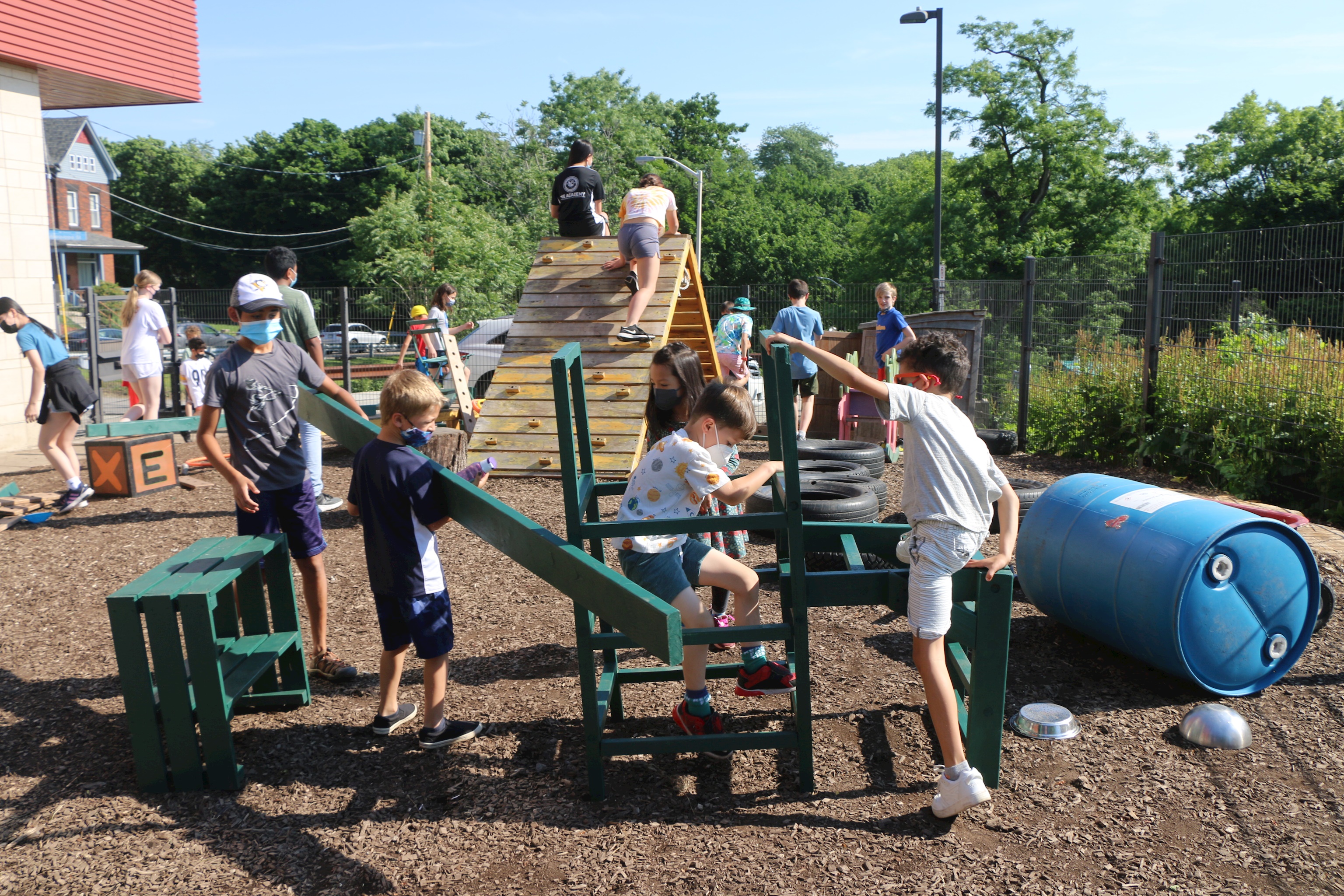Discover our
Home for Learning
- Contact
- 412-624-8020
- [email protected]

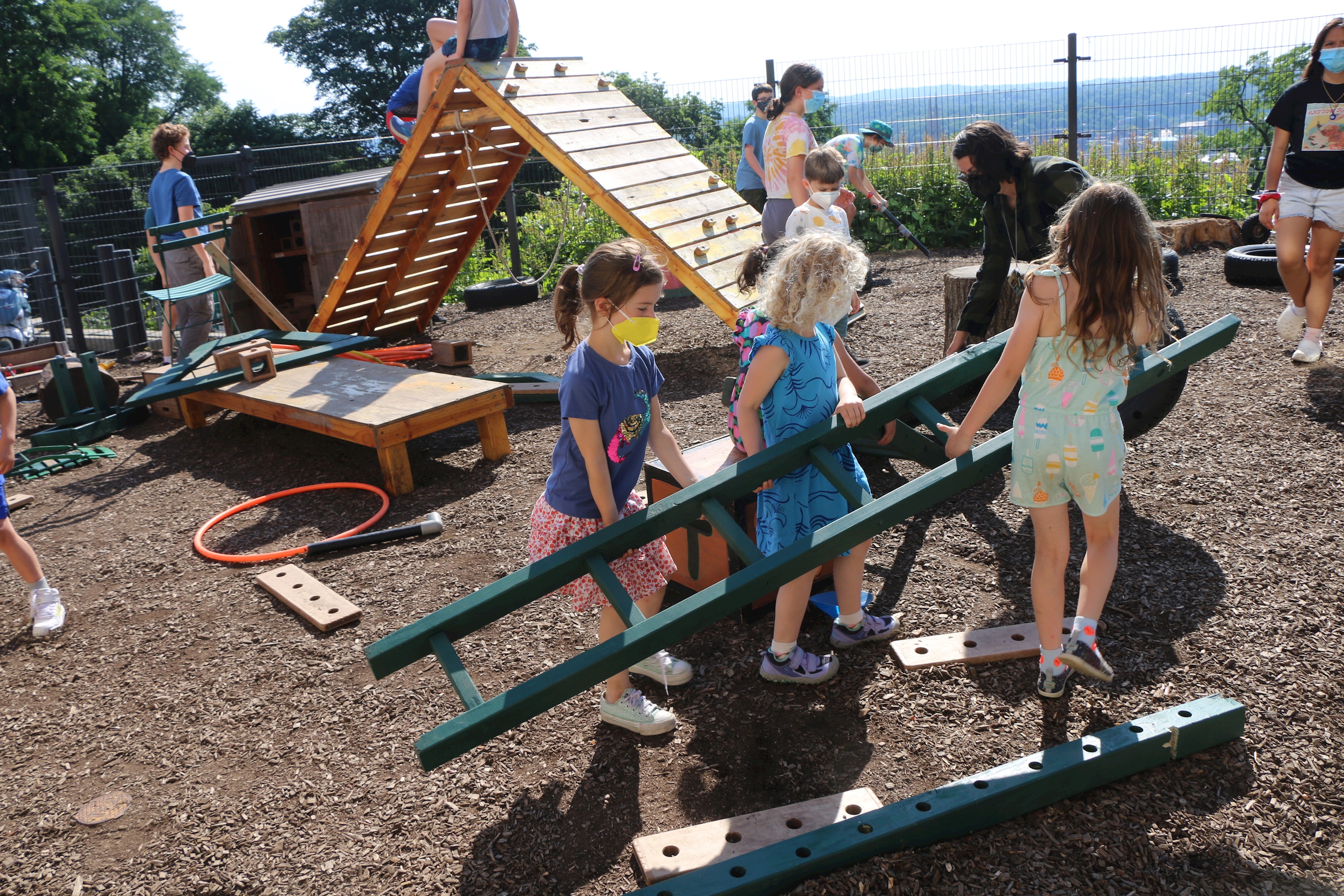 Overlooking the Cathedral of Learning and the University of Pittsburgh campus, in the outdoor play space behind the Falk School’s kindergarten classrooms, a sixth-grader demonstrates to kindergarten students how a ladder can be laid over two play structures to make a bridge. On the concrete beside the school, a soccer game has broken out, with kindergarteners and sixth-graders vying to knock the ball into a green wooden goal.
Overlooking the Cathedral of Learning and the University of Pittsburgh campus, in the outdoor play space behind the Falk School’s kindergarten classrooms, a sixth-grader demonstrates to kindergarten students how a ladder can be laid over two play structures to make a bridge. On the concrete beside the school, a soccer game has broken out, with kindergarteners and sixth-graders vying to knock the ball into a green wooden goal.
It’s the final Monday of the school year, and Falk’s sixth-grade students have just presented kindergarteners with a series of very special items that they’ve made especially for them and for future kindergarten classes. Each piece has been thoughtfully designed and fabricated in Falk’s WonderLab maker classroom.
The items presented to the kindergarteners, which include a climbing structure with multiple-style ladders and planks, the goal, and a new mud kitchen, are part of a Falk tradition of middle-schoolers conceiving, designing, and creating play equipment and other needed items and giving them to the school’s kindergarten classes. The items will be used and appreciated by kindergarteners this year and for years to come.
This making for others is a key part of the WonderLab’s “Wonder, Care, Act” approach. Students wonder about the world around them, care enough to learn deeply about it, and turn these emotions into actions based on their values and understanding.
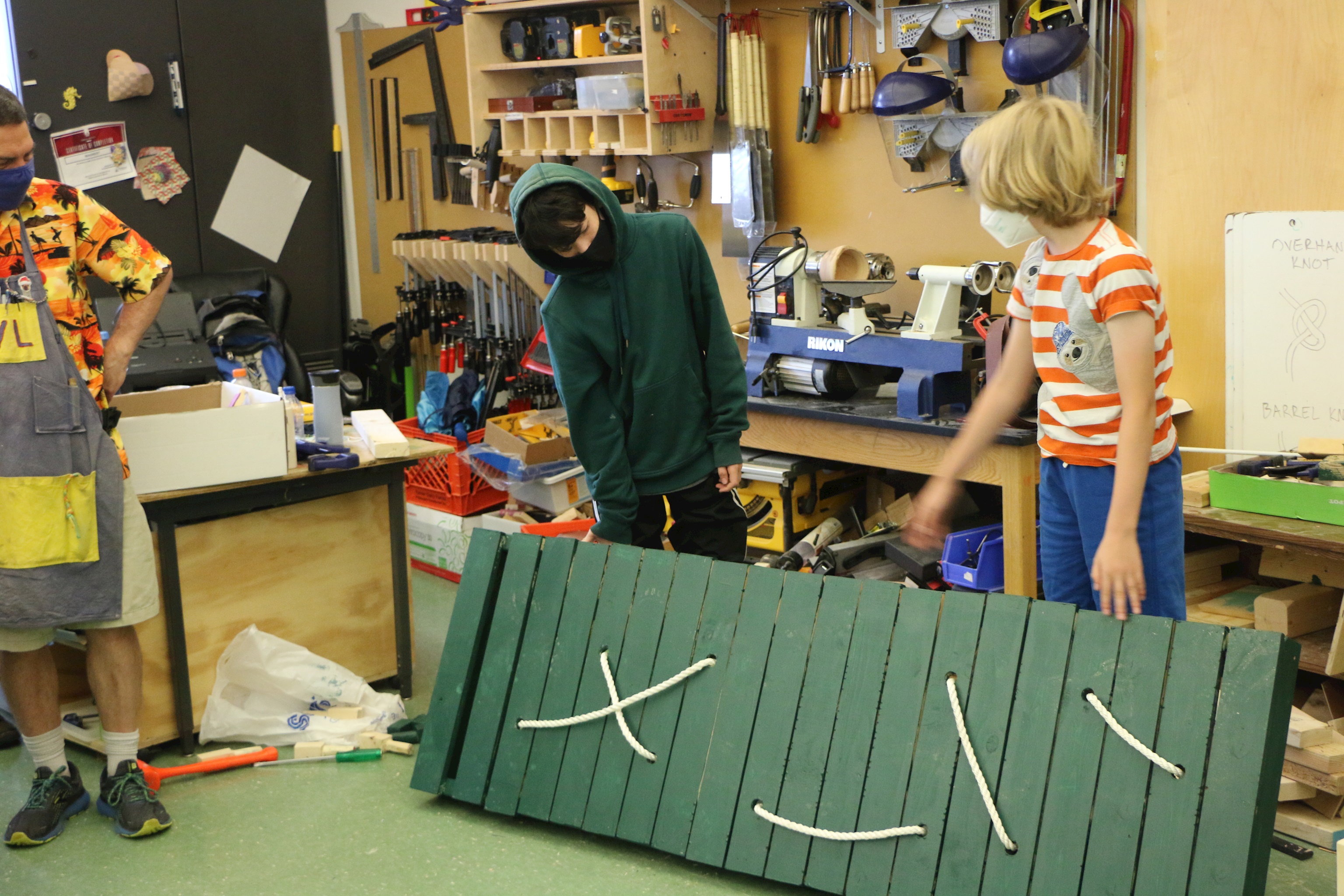 The tradition has been paused since 2020, but this year it’s back in a big way—so big that the presentation of gifts is divided into three days. On Tuesday, forced inside by rain, kindergarteners sit in the WonderLab listening closely as sixth-grade groups detail the processes involved in creating this third series of handmade gifts.
The tradition has been paused since 2020, but this year it’s back in a big way—so big that the presentation of gifts is divided into three days. On Tuesday, forced inside by rain, kindergarteners sit in the WonderLab listening closely as sixth-grade groups detail the processes involved in creating this third series of handmade gifts.
One group shows off its new climbing wall, describing how they used a mallet to join the pieces together. Sixth grade’s focus in WonderLab this year was on using hand tools. With few exceptions, the pieces these students have made for kindergarten were put together using simple but effective techniques like finger joints and bridle joints.
Derek Werderitch, maker educator in the WonderLab, holds up the spade bit students used to drill the holes in the climbing wall that rope passes through. The original idea for the holes, the students say, was to insert pegs that kindergarteners could climb on, but when that didn’t work out they opted for ropes.
“In WonderLab it’s not always about things working out,” says Tim Wagner, maker educator. “It’s about how students adapt and overcome setbacks.”
Another group describes using chisels, knives, and two different kinds of sawteeth: one to make a cross cut and the other to make a rip cut. Wagner holds up an unpainted piece of wood for the kindergarteners, pointing out the direction of the grain. Cutting against the grain, he explains, is a cross cut, and cutting with it is a rip cut.
Two students carry a ladder to the front of the room. They wanted to make something kindergarteners could climb on, one student says, but then they decided to “spice it up” with these crossed beams, which form X’s down the middle of the ladder. And this way, they add, the ladder is sturdier and can be used for more things.
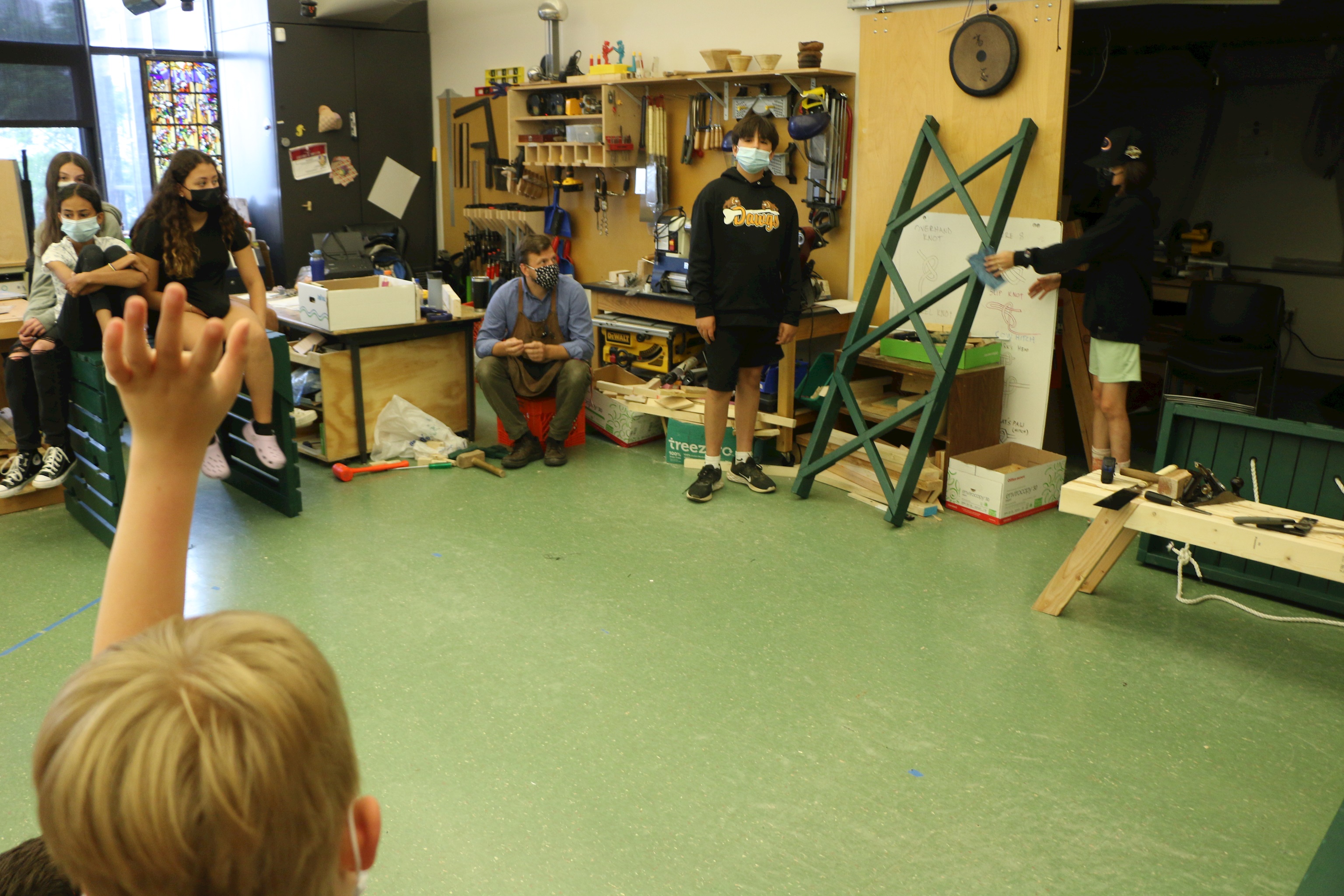 One group presents an open-sided cube so large they had to take it apart to get it through the WonderLab’s door, then reassemble out in the hallway. Kindergarteners can lean a ladder against one edge, a student suggests, but beyond that it’s whatever students, now or in the future, want it to be.
One group presents an open-sided cube so large they had to take it apart to get it through the WonderLab’s door, then reassemble out in the hallway. Kindergarteners can lean a ladder against one edge, a student suggests, but beyond that it’s whatever students, now or in the future, want it to be.
Someone raises a hand. “Is one side up and another side down?” they ask.
“No,” a student says. “And it can go on its side too.”
Creating objects that can be used in multiple ways, depending on the imaginations and interests of kindergarteners, was a running theme common to nearly all of the items the sixth-graders created. In fact, this aim—of creating open-ended materials, play objects, and structures—is part of a bigger project across the school. Parallel to the work of the WonderLab in Middle School, the Kindergarten teachers are part of a city-wide Partners in Play teaching grant, which promotes child-led play and play spaces at Falk Lab School, Faison Elementary School, and Environmental Charter School. One of the aims of this grant is to examine the ways that play and learning cannot be separated during early childhood, especially in relation to how open-ended materials become rich contexts for storytelling narratives, risk-taking, relationship building, and other learning opportunities.
When the WonderLab teachers and Kindergarten teachers met early in the school year about how to proceed with the sixth-grade projects, one of the values that all of the teachers wanted to promote among both Kindergarteners and sixth-graders was the value of multi-use, flexible materials, wherein the Kindergarten children could design their own playground and reinvent their play spaces every day, responding to their unique play stories, contexts, and even environmental provocations, like snow or rain collection.
These values also connect back to Falk Lab School’s Progressive philosophy, history, and mission. At Falk, the teachers aim for the children to have agency, to have a sense of ownership of their learning, and to have countless opportunities to find their voice and tell their unique stories. Kindergarteners tell their stories through play, and the materials they play with take on an essential role in their development. The sixth-graders' work in designing and creating these materials isn't just integral to their Middle School learning, it fits into a whole-school ecosystem at Falk.
 Over the years, the sixth-graders' attention to what kindergarteners need and want has become a hallmark of this developing gift-giving tradition. The class’s work began with a trip to the kindergarten space for observation, play, and inspiration. They played along with the classes, watched how the children play, and asked kindergarten students about their play spaces and what they could use.
Over the years, the sixth-graders' attention to what kindergarteners need and want has become a hallmark of this developing gift-giving tradition. The class’s work began with a trip to the kindergarten space for observation, play, and inspiration. They played along with the classes, watched how the children play, and asked kindergarten students about their play spaces and what they could use.
One sixth-grader says that kindergarteners told them, “We want something to climb on and something to do soccer with.”
The sixth-graders then held special interviews with the Kindergarten teachers in addition to the children. The teachers talked about their values and hopes for the children in Kindergarten, and they talked to the sixth-graders at length about fluidity and flexibility: how open-ended materials could be invented and re-invented, with the Kindergarteners’ stories, creative vision, and industrious play as their guide.
Through all of these conversations and observations, the sixth-graders quicky integrated open-endedness—creating objects that are good for more than one purpose—into their approach to making for the kindergarten playground.
The class took that information back to the WonderLab, where their design processes led them to build everything from a range of different-sized ladders to a small triangular soccer goal, to a tall, open structure with enough room inside to stand in or crawl through, and sturdy enough to climb on. The ladders could be stretched between different structures, or placed between the large tires that populate the outdoor space.
When they visited the kindergarteners’ space, sixth-graders also noticed the popular mud kitchen, a place to mix mud and store tools like spades and rakes, had been badly weathered by years of rain and snow. So a new one, dressed in a fresh coat of green paint to protect against the elements, was among this year’s gifts.
This year’s gifts will decorate the kindergarten space alongside the high climbing wall that was made by the Class of 2021. Elsewhere in the school, Wagner says, WonderLab classes have contributed items like wooden Chromebook holders, the Gaga pit, and a range of objects for use in spaces like Falk Woods and the yoga studio.
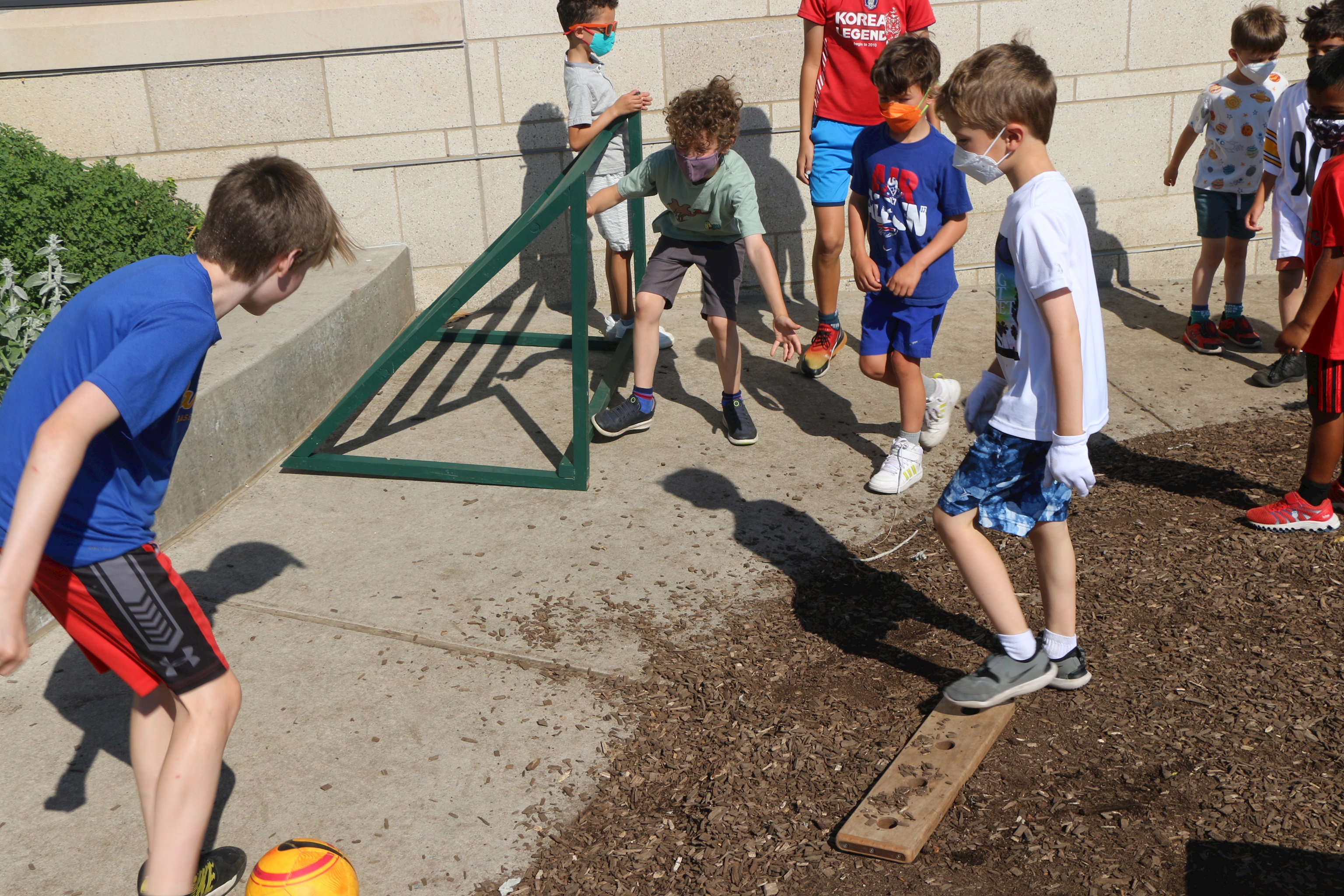 Like many of the traditions and practices that make a Falk School education distinctive, the gift-giving tradition is informed by considerable thought and discussion, and especially by research that has shown making something for someone else is a more meaningful experience than making something for oneself.
Like many of the traditions and practices that make a Falk School education distinctive, the gift-giving tradition is informed by considerable thought and discussion, and especially by research that has shown making something for someone else is a more meaningful experience than making something for oneself.
At the conclusion of Tuesday’s gift presentation, Falk School director Jill Sarada raises her hand to ask the sixth-graders a question.
“How would you have felt when you were kindergarteners,” she asks, “if middle school had made something for you?”
“It would be awesome!”
“It is such a gift you are giving,” Sarada tells the class. “You’re giving them objects they are going to use the rest of this year and for years to come, but eventually they will return this gift by creating something when they are sixth-graders.
“You’ve started a cycle that will be continued,” she adds. “I hope you recognize the joy you are bringing.”
